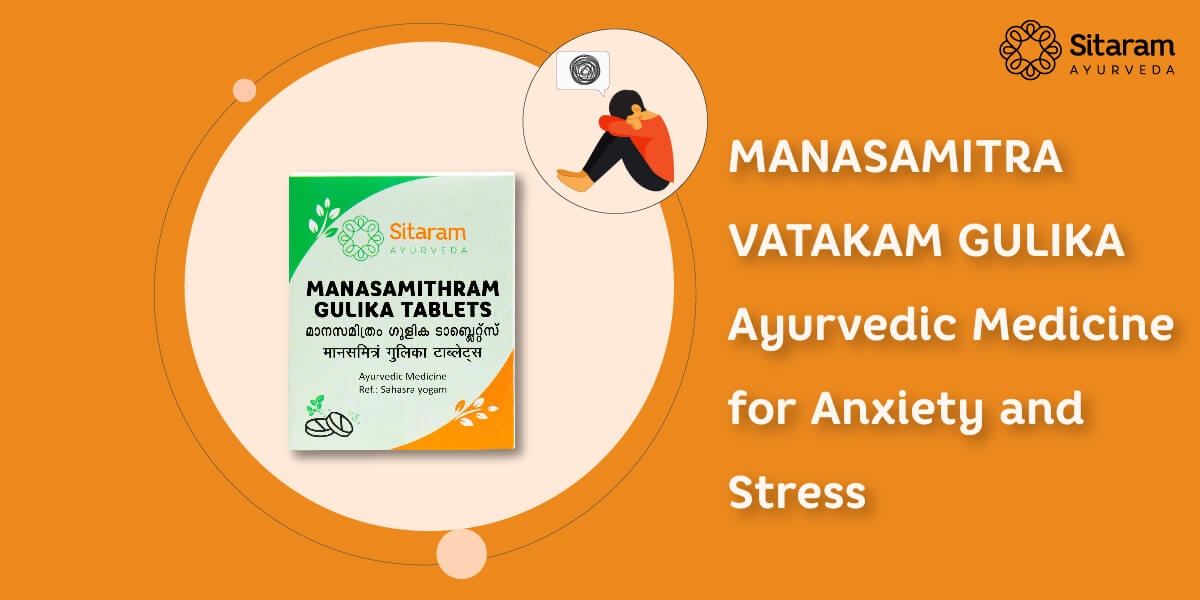Ayurvedic medicine for anxiety and stress – Manasamitra Vatakam

Manasamitra vatakam gulika, a beautiful combination of herbal powders, and purified minerals. The name Manasamitram indicates – ‘the friend of mind’. Manasamitra Vatakam Gulika pills improve mental performance and calm frayed nerves.
Benefits of Manasamitra Vatakam Gulika
Manasamitra Vatakam Gulika works best on the nervous system and the brain. The medicine helps to increase focus, memory, and alertness. Additionally stimulating the mind, speech, and cognition; it effectively helps in the treatment for irregular brain and central nervous system activity.
The use of Manasamitra Vatakam Gulika pills in the treatment of illnesses with psychosomatic causes is also useful. The medicine is very supportive in the treatment of depression, anxiety, and other mental illnesses.
Ingredients – Bala (Sida cordifolia), Aparajitha (Clitoria ternatea), Vacha (Acorus calamus), Patola (Trichosanthus dioica), Shatavari (Asparagus recemosa), Tulasi (Osmium sanctum), Brahmi (Bacopa monnieri), Durva (Cyonodon dactylon), Shilajith, Swarna bhasm
Dosage
- For Adults – 1-2 tablets of Manasamitra Vatakam gulika twice daily on empty stomach, dissolved in a an ounce of milk.
- For Children – 1/2-1 tablet once or twice daily on empty stomach, dissolved in half an ounce of milk.
In today’s world, it’s common to have uneasiness or anxious behavior every now and then. However, strong, excessive, and persistent worry and panic over commonplace circumstances are typically experienced by those with anxiety disorders. Anxiety disorders sometimes entail recurrent episodes of acute anxiety, fear, or terror that peak in a matter of minutes (panic attacks).
These uncomfortable, hard-to-regulate, out-of-proportion to the real threat and protracted sensations of worry and panic interfere with daily activities. To stop these feelings, you could avoid certain locations or circumstances. Generalized anxiety disorder, social anxiety disorder (social phobia), individual phobias, and separation anxiety disorder are a few examples of anxiety disorders. There are various types of anxiety disorders. There are situations when anxiety is a symptom of a disease that requires care.
The types of anxiety disorders
- Agoraphobia – Agoraphobia is a form of anxiety disorder in which a person fears and frequently avoids locations or circumstances that can make them feel confined, helpless, or ashamed.
- Intense anxiety – Intense anxiety or panic sensations that are directly attributed to a physical health issue are included in anxiety disorders that are caused by medical conditions.
- Generalised anxiety disorder – Anxiety and worry about things that are commonplace or routine, as well as persistent and excessive anxiety, are symptoms of generalized anxiety disorder. The worry is excessive compared to the situation, hard to regulate, and has an impact on how you physically feel. It frequently co-occurs with depression or other anxiety disorders.
- Panic disorder – Repeated episodes of abrupt, acute anxiety, fear, or terror that peak in intensity in a matter of minutes are symptoms of panic disorder (panic attacks). Shortness of breath, chest pain, or a fast, fluttering, or pounding heart are possible signs of imminent catastrophe (heart palpitations). These panic episodes may cause concern that they’ll happen again or a desire to stay away from circumstances where they’ve happened.
- Separation anxiety disorder – A childhood disorder called separation anxiety disorder is characterized by excessive anxiety for the child’s developmental stage and anxiety associated to separation from parents or other adults who play parental duties.
- Social Anxiety disorder – High degrees of anxiety, fear, and avoidance of social situations are symptoms of social anxiety disorder (social phobia), which are brought on by emotions of humiliation, self-consciousness, and worry about being judged or perceived adversely by others.
- Specific phobias – Major anxiety when exposed to a particular object or scenario and a desire to avoid it are characteristics of certain phobias. Some people experience panic episodes due to phobias.
- Substance-induced anxiety disorder – Intense anxiety or panic symptoms that are a direct result of drug abuse, prescription use, toxic substance exposure, or drug withdrawal are the hallmarks of substance-induced anxiety disorder.
- The terms “other specified anxiety disorder” and “unspecified anxiety disorder” refer to phobias and anxieties that do not quite fit any of the other anxiety disorder definitions but are significant enough to be distressing and disruptive.
Symptoms of anxiety
The following list of symptoms and indicators of anxiety:
- Feeling jittery, fidgety, or uptight
- A feeling of impending peril, terror, or disaster
- Having a faster heartbeat
- Breaths quickly (hyperventilation)
- Sweating
- Trembling
- Feeling drained or feeble
- Difficulty focusing or thinking about anything but the current issue
- Having issues falling asleep
- Having digestive system (GI) issues more often
- Having trouble managing worry
- A desire to stay away from things that make you anxious


 Sign In
Sign In Cart
Cart